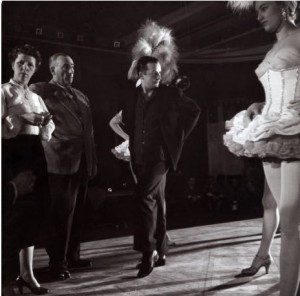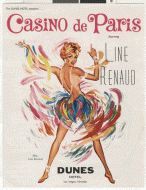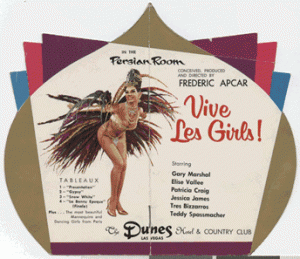MLA/TLA Program at the ALA Annual Conference: Performing Vegas: Documenting Music and Stage in Sin City
On Saturday, June 28, it was my pleasure to moderate the co-sponsored 2014 program of the Music Library Association and the Theatre Library Association at the ALA Annual Conference in Las Vegas. Titled “Performing Vegas: Documenting Music and Stage in Sin City,” the program featured three speakers from the University of Nevada, Las Vegas who highlighted regional performance history and its documentation by UNLV Special Collections. A very diligent audience of attendees made their way through the astounding vastness of Caesar’s Palace to hear a fantastic and informative presentation.

Photograph of Donn Arden, Margaret Kelly and Pierre-Louis Guérin with dancers, Paris, France, circa 1950s, UNLV Libraries, Digital Collections, Donn Arden Collection
Current Head of Exhibits for the UNLV Libraries, Peter Michel, started off the panel with a rich visual and historical overview of Las Vegas shows. This included the early inspiration of dance and music halls in Paris, the connection of the show spectaculars to hotel development, and the use of nudity as a source of competition between shows. He particularly spotlighted the influential importance of Donn Arden’s shows and the role of Arden’s collaborator Margaret Kelly, known as “Madame Bluebell,” in helping to create the iconic image of nightclub show dancers as manager of the Bluebell Girls.
Su Kim Chung, Head of Special Collections Public Services at UNLV, next detailed the specific collections and types of performance documentation collected by the institution. She clarified that far from just one “showgirls collection,” UNLV houses many different sets of materials that have been acquired and processed at through the years. Among the most popular is the Sands Hotel Collection, which contains photos of the Rat Pack, but UNLV is also home to other hotel and city publicity materials, entertainment periodicals, and a substantial number of show programs. The collections contain documentation of burlesque history in Las Vegas, particularly of Arden and Minsky shows, and these complement the Burlesque Hall of Fame museum also located in the city. An important part of the collections is the presence of colorful costume sketches, including Bob Mackie designs, but equally important are employment contracts that reflect the arduous schedule for dancers in the 1950s and 60s, as well as oral histories of performers and musicians. Major recent acquisitions include the scrapbooks of Madame Bluebell, which complement the existing Donn Arden collection.
Last but not least, Music Librarian and Adjunct Professor of Music History Cheryl Taranto discussed music history in Las Vegas and the challenges of collecting and documenting this often incohesive area of the city’s entertainment culture. She noted several distinct but interrelated areas of music history, including performers/arrangers/composers involved with show spectaculars, lounge acts created as competition to showgirls performances, and musicals. Although there are select musical parts, the collection does not contain complete music for any one show spectacular. This is in part because of often poor show documentation practices, as the music was typically not critically acclaimed and the arranger and composer are not always identified or known. The collection does contain some informative materials on music contracts, however, as well as legal documents reflecting a copyright suite over the use of music from Kismet. Examples of more lucrative historical Las Vegas lounge acts include the Mary Kaye Trio, Louis Prima, Artie Shaw, Wayne Newton, Cab Calloway, Mel Torme, and Liberace. And, while the rise of musicals created more competition for lounge acts, they also provided more job opportunities for working musicians. Notable shows include Minsky Goes to Paris, Lido de Paris, and Hallelujah Hollywood.
This synopsis is just the tip of the iceberg for all the information and details covered by our speakers. I encourage anyone interested in learning more to visit UNLV Special Collections, and to read more about the collections online.
- UNLV Showgirls Digital Collections: http://digital.library.unlv.edu/collections/showgirls
- The Lasting Legacy of Las Vegas Showgirls: http://news.unlv.edu/article/lasting-legacy-las-vegas-showgirls
- UNLV Special Collections Finding Aids: http://www.library.unlv.edu/speccol/databases/index.php
- Projects of the Oral History Research Center: https://www.library.unlv.edu/speccol/ohrc/projects
Diana King
University of California, Los Angeles


